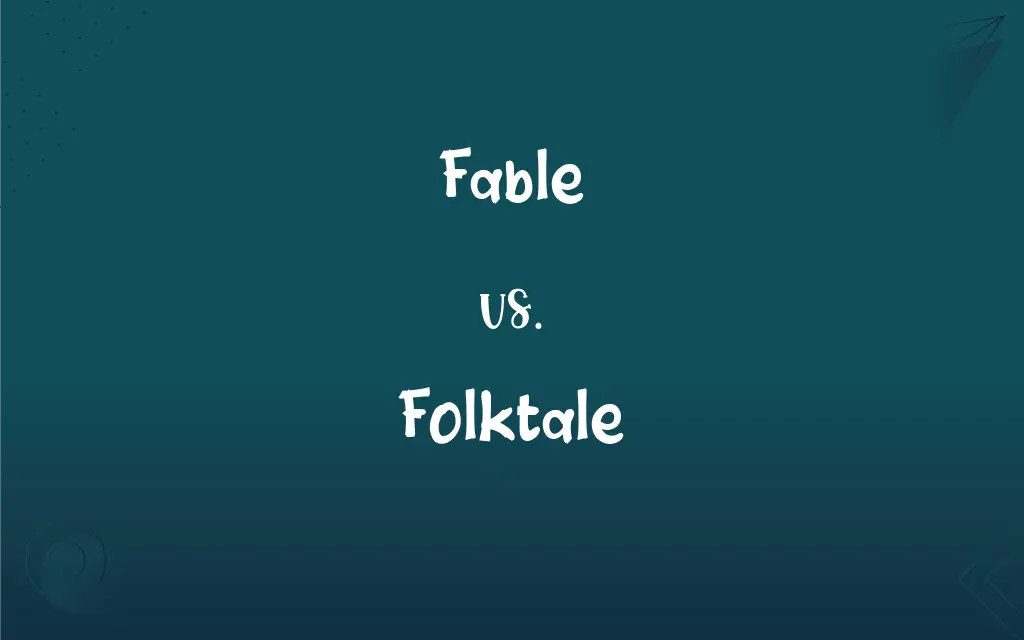Fable vs. Folktale: What's the Difference?
Edited by Janet White || By Harlon Moss || Updated on June 6, 2024
A fable is a brief story, often featuring animals, that conveys a moral lesson, while a folktale is a traditional story passed down through generations, reflecting cultural beliefs.

Key Differences
A fable is a succinct narrative, usually employing animals as characters, that delivers a moral or ethical lesson. In contrast, a folktale is a story deeply rooted in a particular culture or society, representing its values, beliefs, and traditions.
Originating from various societies and historical periods, fables are universal tales that target teaching moral principles. Folktales, on the other hand, are specific to a cultural group and are preserved by being passed orally from one generation to the next.
The characters in a fable, often non-human, are designed to highlight certain virtues or flaws. In folktales, while there may be fantastical elements, characters often represent common people and situations from a particular cultural backdrop.
Commonly, the fable concludes with a definitive moral or lesson, making its teaching intent explicit. Folktales might not always have a clear moral but can offer insights into cultural norms and values.
While fables can be easily adopted and adapted by various cultures due to their universal themes, folktales remain tethered to their cultural origins, celebrating the distinct identity of a community.
ADVERTISEMENT
Comparison Chart
Primary Purpose
To teach a moral lesson
To reflect and preserve cultural beliefs and values
Characters
Often animals with human traits
Humans, gods, or mythical creatures; specific to a culture
Origin
Universal, not tied to a specific culture
Rooted in a specific culture or society
Narrative Length
Typically brief
Varies; can be long or short
Concluding Message
Direct moral at the end
Not have an explicit moral, but provides cultural insight
ADVERTISEMENT
Fable and Folktale Definitions
Fable
A tale that uses allegorical characters to symbolize human virtues or flaws.
In the fable of The Ant and the Grasshopper, the ant represents diligence.
Folktale
A traditional story passed orally through generations.
Paul Bunyan is a popular American folktale.
Fable
A narrative that imparts a lesson through its characters' actions.
Aesop's fables are widely read and known for their moral teachings.
Folktale
A narrative reflecting the beliefs and customs of a specific culture.
The Cinderella story, as a folktale, has different versions across cultures.
Fable
A universally relevant tale that aims to instill moral values.
The fable of The Fox and the Grapes addresses the nature of sour grapes.
Folktale
A story preserving cultural identity and shared community values.
African folktales often use animals to represent different tribal attributes.
Fable
A short story, often with animals, conveying a moral.
The Tortoise and the Hare is a fable about the value of persistence.
Folktale
A tale encompassing mythical elements or cultural heroes.
Folktales from Scandinavia often feature trolls and giants.
Fable
A story where the conclusion offers a clear teaching or principle.
The fable of The Boy Who Cried Wolf warns against lying.
Folktale
A non-religious narrative that originates from the shared memory of a society.
The folktale of Johnny Appleseed showcases the pioneering spirit of early America.
Fable
A usually short narrative making an edifying or cautionary point and often employing as characters animals that speak and act like humans.
Folktale
A story or legend forming part of an oral tradition.
Fable
A story about legendary persons and exploits.
Folktale
A tale or story that is part of the oral tradition of a people or a place.
Fable
A falsehood; a lie.
Folktale
A tale circulated by word of mouth among the common folk, especially one forming part of the tradition of a culture.
Folktale
A tale circulated by word of mouth among the common folk
FAQs
How do folktales differ from fairy tales?
While both are traditional stories, fairy tales often involve magic and fantastical creatures, while folktales can encompass a broader range of narratives rooted in cultural traditions.
Are folktales factual accounts?
No, folktales are fictional stories that reflect cultural beliefs.
Who is a famous fable writer?
Aesop is a renowned ancient Greek fable writer.
How do folktales influence culture?
Folktales reinforce cultural norms, pass down traditions, and shape societal values and beliefs.
How are animals typically portrayed in fables?
In fables, animals often exhibit human-like characteristics.
What's the main aim of a fable?
A fable primarily aims to teach a moral lesson.
How is a folktale typically passed down?
Folktales are often passed down orally through generations.
Are folktales always old stories?
While many are ancient, new folktales can emerge reflecting contemporary cultural values.
Do fables belong to specific cultures?
Fables are universal and can be found in many cultures, often with variations.
What's the difference between folktales and myths?
Myths are religious or sacred tales explaining the universe, while folktales are secular, cultural stories.
Can modern stories be considered fables?
Yes, modern stories can be fables if they convey a moral lesson, regardless of their time of origin.
Can a fable's moral vary between cultures?
Yes, the same fable can be interpreted differently or emphasize varied morals across cultures.
Can fables have human characters?
Yes, while animals are common in fables, human characters can also appear.
What are some common themes in folktales?
Folktales often explore themes like heroism, trickery, love, and conflict, reflecting societal values and beliefs.
Are fables true stories?
No, fables are fictional tales designed to teach a specific moral lesson.
Why are folktales important to study?
Studying folktales offers insights into a culture's values, history, and societal norms.
Are there folktales shared across multiple cultures?
Yes, similar folktales can be found across cultures, though they might have variations reflecting each culture's unique values.
Do fables always conclude with a stated moral?
While many fables end with a clear moral, some leave it to the reader to discern the lesson.
How do fables differ from parables?
While both teach lessons, fables often use animals, whereas parables, typically religious, use human characters to convey spiritual lessons.
Can a story be both a fable and a folktale?
It's possible if a cultural story with a clear moral gets passed down through generations.
About Author
Written by
Harlon MossHarlon is a seasoned quality moderator and accomplished content writer for Difference Wiki. An alumnus of the prestigious University of California, he earned his degree in Computer Science. Leveraging his academic background, Harlon brings a meticulous and informed perspective to his work, ensuring content accuracy and excellence.
Edited by
Janet WhiteJanet White has been an esteemed writer and blogger for Difference Wiki. Holding a Master's degree in Science and Medical Journalism from the prestigious Boston University, she has consistently demonstrated her expertise and passion for her field. When she's not immersed in her work, Janet relishes her time exercising, delving into a good book, and cherishing moments with friends and family.































































